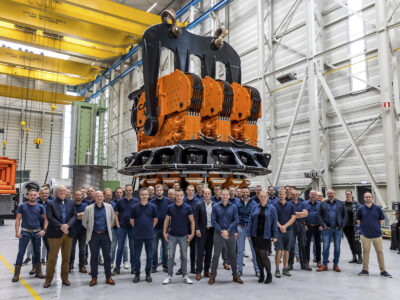Vibro driving
the next chapter
in offshore wind
VIBRO DRIVING: THE NEXT CHAPTER IN OFFSHORE WIND
In the search for alternative ways to make foundation installations quieter, faster and easier, the offshore vibro driving technology has developed in leaps and bounds over the past 20 years. The ever-increasing demand for reducing the Levelised Cost of Energy (LCOE) and protecting the underwater wildlife, has triggered out of the box thinking for the foundation pile installation.
The origin of vibro driving on land goes back to the 1930’s. It became more common offshore about 20 years ago, when onshore vibro hammers were used to install relatively small piles. Since then the largest land vibro hammers have been used occasionally, sometimes combining several of them for larger diameters or when more power was required. The current record is ‘piles’ with a diameter of 30 metres, driven with a multiple linked vibro in China.
After entering the offshore market with vibro hammers back in 2008, CAPE Holland developed a multiple vibro for the first ever monopile for a wind turbine generator in 2012. In the German exclusive zone, the monopiles for the Riffgat Offshore Wind Farm were driven to a stable depth, without noise mitigation before they were driven to their final depth with an impact hammer, due to the strict German regulations. The same regulations also required noise mitigation for this last stage of the driving process.
The success of driving the 30 monopiles to the desired depth, in about 20 minutes net driving time, on average per pile, convinced the CAPE Holland management that there was a gap in the market for a fast way of driving piles, without too much noise impact. This was great opportunity for the offshore wind industry.
We realised, however, that the large onshore vibro hammers were not ideal for offshore use and in 2014 we took the plunge and developed a dedicated vibro hammer for the offshore market. It incorporated an upending facility and was designed and built as a lifting tool, certified for lifting offshore. (Lloyd’s Register CLAME; Code for a Lifting Appliance in a Marine Environment). Due to the combination of the lifting tool and vibro driver, we called it the CAPE Vibro Lifting Tool or CAPE VLT in short.

The first application of the new certified tool was in early 2015. It was for the pre-piling of jacket piles for a gas platform in the Culzean field at 90m water depth. The four piles were all driven to their target depth before they were driven to final penetration with an impact hammer.

Due to the hard soil layers the contractor would otherwise have had to use a small impact hammer first, up until the piles were stable enough to put the large hammer on top of the piles. This would have meant that the piles would have to be put into the template first with an internal lifting tool, then driven with a small impact hammer and finally with an big impact hammer. This would have resulted in many more lifts, which at this water depth would have been rather time consuming.
However, with the CAPE VLT, the contractor was able to pick up the stored piles from the deck, upend them with the 2 cranes of the semi-submersible HLV, sink them to 90m water depth and after positioning them in the template, drive them to their target depth. The whole operation, from lifting the first pile to bringing the CAPE VLT back on deck after the last pile, took less than 6 hours.
Having showed its great potential with the CAPE VLT-320, We built the first multiple linked CAPE VLT in 2016. This was for the installation of a monopile for the foundation of an unmanned gas platform in the Dutch part of the North Sea. By using the CAPE VLT the pile could be installed, without any form of support frame during driving.

By hanging in the crane, the pile and CAPE VLT combination act as a dead weight, with the laws of physics pulling it vertically. The CAPE Inclino system, monitored the verticality, so the contractor could make any corrections with the position of the crane and vessel whilst driving the pile. The result was a verticality of 0.2 degrees, where a tolerance of 0.5 degrees was set.
More and more contractors saw the massive benefits of the offshore vibro lifting tool, fueling the demand for a smaller version, which led to the development of the CAPE VLT-80 with a range from 30 to 84 inch. This compact unit, which has been has been flown out to a few projects around the globe already, is mostly used for the installation of pin piles for seabed structures and anchor piles for mooring systems. This has a great potential for anchor piles for floating wind projects.
It has been used successfully in the Caspian Sea to water depths of 170m installing tether piles to final penetration, saving an enormous amount of installation time driving the piles free hanging, as a seabed frame was not required. No tool changes were required, as the full installation from picking up the stored piles, to driving them to final penetration before picking up the next pile happened with the same tool. The whole installation campaign, took less than half the time it would have taken with the traditional installation method.
Although the oil and gas market seemed to embrace the ‘new’ technology fairly quickly, the use of vibro hammers in the offshore wind industry lagged behind. Some test projects were organised to disperse the myths about the bearing capacity of vibro piles, but did not immediately spark the interest of the developers, even though the potential in the offshore wind is very significant.

After successfully driving and extracting 7 months later, for an onshore test monopile in 2016, the initiator of the SJOR (Slip Joint Offshore Research) project also choose to drive the monopile foundation of their offshore test to final penetration with the CAPE VLT in 2018. During this campaign, the pile was installed three times and extracted twice. The plan is was to extract the pile with the CAPE VLT later that year.

Another monopile, this time of 6.5m diameter, was installed at the Maasvlakte in Rotterdam in the same year from a crane barge in a record of 15 minutes net driving time, to the final penetration of 24m in sandy soil.

The combination of the CAPE VLT being clamped to the pile and keeping weight in the crane during driving, means that the contractor is in full control of the installation. There is also the added benefit that the risk of a drop fall and pile run is eliminated. This risk is present in various parts of the world due to the specific geotechnical build-up of the soils. Off the coast of Taiwan for example the risk is significant and a reason why a contractor used a multiple linked CAPE VLT at an offshore wind farm in early 2019, to drive the piles through the risky soil layers.

A major milestone has been reached recently, as CAPE Holland has been selected to supply a CAPE VLT and operating crew for the installation of the wind turbine generator monopiles to final penetration, for the Kaskasi Offshore Wind Farm, in the German Bight. This project is planned to start in Q3 2021 and will see the largest CAPE VLT ever built. An additional novelty is that it will be the first project whereby flanged monopiles will be upended and driven with a CAPE VLT. The development for this new tool is well underway and is likely to set a new trend in the Offshore Wind industry.
VIBRO
LIFTING
TECHNOLOGY

Discover how its unique features will uplift your next project; download the vibro lifting technology guide.



